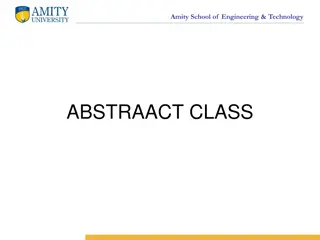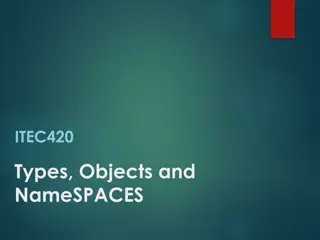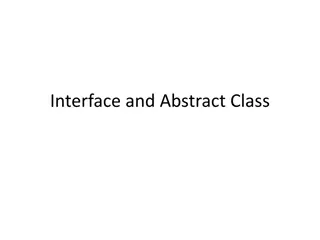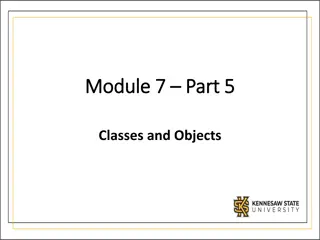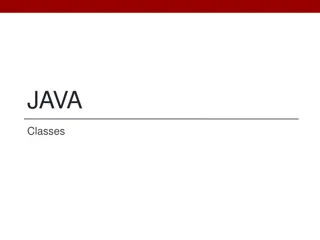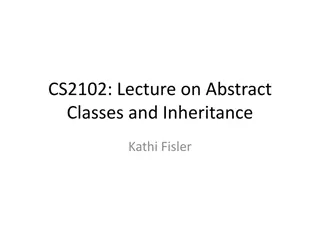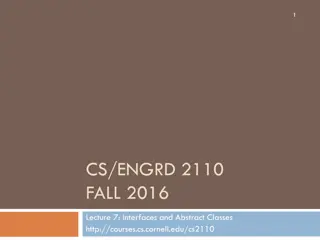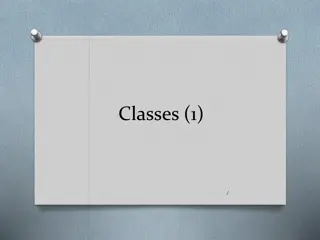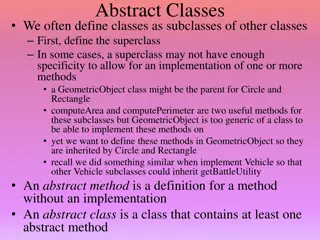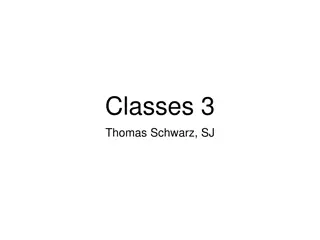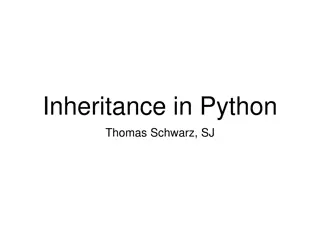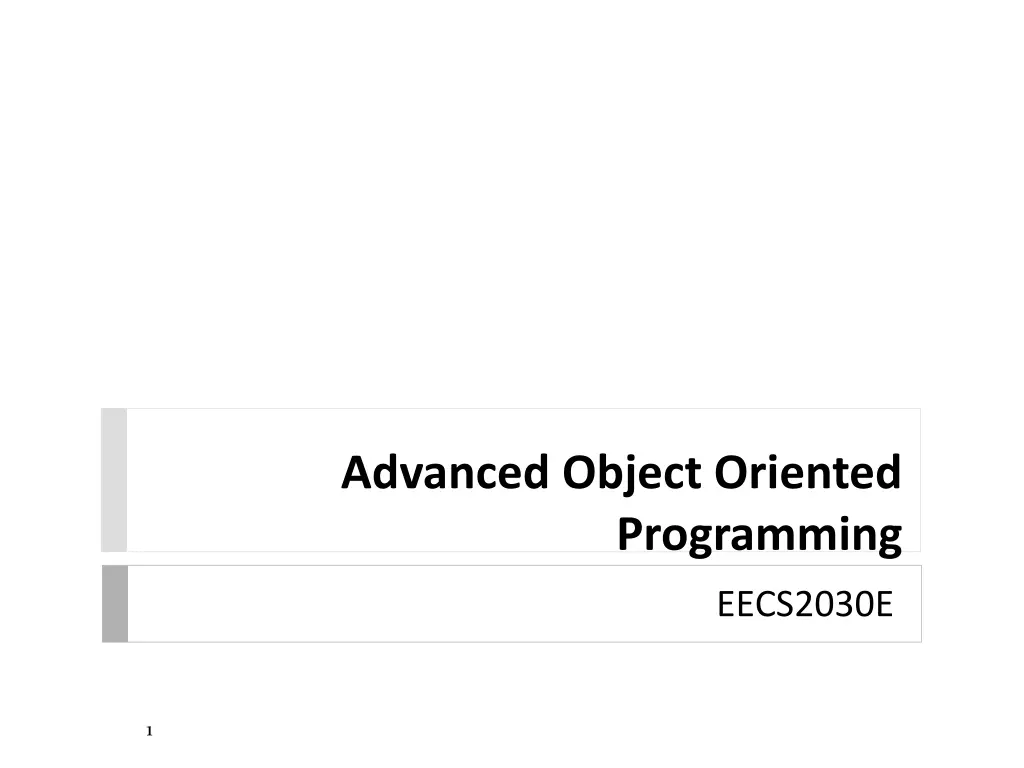
Advanced Object Oriented Programming Course Information
"Learn about the Advanced Object Oriented Programming course EECS2030E1 at York University, covering course format, labs, tests, exam details, iClicker exercises, and recommended textbooks. Get details on Dr. Burton Ma, office hours, and more."
Download Presentation

Please find below an Image/Link to download the presentation.
The content on the website is provided AS IS for your information and personal use only. It may not be sold, licensed, or shared on other websites without obtaining consent from the author. If you encounter any issues during the download, it is possible that the publisher has removed the file from their server.
You are allowed to download the files provided on this website for personal or commercial use, subject to the condition that they are used lawfully. All files are the property of their respective owners.
The content on the website is provided AS IS for your information and personal use only. It may not be sold, licensed, or shared on other websites without obtaining consent from the author.
E N D
Presentation Transcript
Advanced Object Oriented Programming EECS2030E 1
Who Am I? Dr. Burton Ma office Lassonde 2046 hours : Tue 13:30-15:30 email burton@cse.yorku.ca 2
Course Format everything you need to know will eventually be on the York University Moodle site https://moodle.yorku.ca/moodle/course/view.php?id=139785 if you are enrolled in this course then you should have access to the course 3
Labs in Prism computing labs (LAS1006) Lab Zero starts in Week 1 self-guided, can be done anytime before 11:59PM Sep 14 using the Prism lab environment using eclipse Labs 1-7 consist of a different set of programming problems for each lab Lab 1 starts Sep 17 it is expected that you know how to use the lab computing environment 4
Labs group lab work is allowed and strongly encouraged for Labs 1-7 (not Lab 0) groups of up to size 3 see Academic Honesty section of syllabus TLDR Do not submit work that is not wholly your own 5
Tests all testing occurs during your regularly scheduled lab using the EECS labtest environment Test Weight of total grade Test 1 20% Test 2 15% miss a test for an acceptable reason? see Evaluation: Missed tests section of syllabus 6
Exam set by the Registrar worth 36% of your total grade for Section E 7
iClicker iClicker exercises in every lecture (except this one) 0.25% per lecture for a maximum of 4% of your total grade responses are graded 8
Textbook a set of freely available electronic notes is available from the Moodle site recommended textbooks Building Java Programs, 4th Edition, S Roges and M Stepp Introduction to Programming in Java, 2nd Edition, R Sedgewick and K Wayne does not cover inheritance Absolute Java, 6th Edition, W Savitch recommended references Java Pocket Guide, Liguori and Liguori Effective Java, 3rd Edition, J Bloch 9
Type a type is a set of values and the operations that can be performed with those values for example: int 32-bit signed integer value between Integer.MIN_VALUE and Integer.MAX_VALUE +, -, *, /, %, ==, !=, >, <, and more java.lang.String a sequence of zero or more Unicode characters ==, equals, charAt, indexOf, substring, and many more java.util.List a sequence of zero or more elements of the same type ==, equals, get, set, subList, and many more 11
Primitive Types in Java the primitive types are the built-in numeric types and the type boolean Category Type byte char Integer short int long float Floating-point double True/false boolean 12
Reference Types every type that is not primitive is a reference type for example: int[] an array if int values all arrays (even arrays of primitive values) are reference type java.lang.String java.util.List java.util.ArrayList and so on... 13
Class a class is an implementation of a type in Java, a class is also a type but not all types are classes for example: java.lang.String java.util.ArrayList an implementation of the type java.util.List java.util.List is not a class 14
Object an object is an instance of a class a class is a blueprint that is used to make objects for example: List<String> t = new ArrayList<>(); uses the ArrayList class to create an ArrayList object 15
Reference a reference is an identifier that can be used to find a particular object in many Java implementations, references are memory addresses in Java, any variable whose type is not a primitive type stores a reference for example: List<String> t = new ArrayList<>(); t is a reference to the object created on the right-hand side of the assignment 16
Memory Diagrams a memory diagram can be helpful for understanding the differences between primitive and reference types a memory diagram is simply a table with 3 columns variable name address value 98 99 100 101 102 ... 700 17
Memory Diagrams double x = -1.0; List<String> t = new ArrayList<>(); variable name address value 98 99 x 100 -1.0 t 101 700a 102 ... 700 ArrayList<String> object 18
Organization of a Java Program Packages, classes, fields, and methods 19
Organization of a Typical Java Program one or more files 20
Organization of a Typical Java Program one or more files zero or one package name 21
Organization of a Typical Java Program one or more files zero or one package name zero or more import statements 22
Organization of a Typical Java Program one or more files zero or one package name zero or more import statements one class 23
Organization of a Typical Java Program one or more files zero or one package name zero or more import statements one class one or more fields (class variables) 24
Organization of a Typical Java Program one or more files zero or one package name zero or more import statements one class zero or more fields (class variables) zero or more more constructors 25
Organization of a Typical Java Program one or more files zero or one package name zero or more import statements one class zero or more fields (class variables) zero or more more constructors zero or more methods 26
Organization of a Typical Java Program it's actually more complicated than this static initialization blocks non-static initialization blocks classes inside of classes (inside of classes ...) classes inside of methods anonymous classes lambda expressions (in Java 8) modules (in Java 9) see http://docs.oracle.com/javase/tutorial/java/javaOO/index.html 27
Packages packages are used to organize Java classes into namespaces a namespace is a container for names the namespace also has a name 28
Packages packages are use to organize related classes and interfaces e.g., all of the Java API classes are in the package named java 29
Packages packages can contain subpackages e.g., the package java contains packages named lang, util, io, etc. the fully qualified name of the subpackage is the fully qualified name of the parent package followed by a period followed by the subpackage name e.g., java.lang, java.util, java.io 30
Packages packages can contain classes and interfaces e.g., the package java.lang contains the classes Object, String, Math, etc. the fully qualified name of the class is the fully qualified name of the containing package followed by a period followed by the class name e.g., java.lang.Object, java.lang.String, java.lang.Math 31
Packages packages are supposed to ensure that fully qualified names are unique this allows the compiler to disambiguate classes with the same unqualified name, e.g., your.String s = new your.String("hello"); String t = "hello"; 32
Packages how do we ensure that fully qualified names are unique? package naming convention packages should be organized using your domain name in reverse, e.g., EECS domain name eecs.yorku.ca package name ca.yorku.eecs we might consider putting everything for this course under the following package eecs2030 33
Packages we might consider putting everything for this course under the following package eecs2030 labs might be organized into subpackages: eecs2030.lab0 eecs2030.lab1 and so on tests might be organized into subpackages: eecs2030.test1 eecs2030.test2 and so on 34
Packages most Java implementations assume that your directory structure matches the package structure, e.g., there is a folder eecs2030 inside the project src folder there is a folder lab0 inside the eecs2030 folder there is a folder lab1 inside the eecs2030 folder, and so on 35
Packages project folder project sources folder eecs2030 folder lab0 folder 36
Classes 37
Classes a class is an implementation of a type a class is (usually) used as a blueprint to make instances of the class (objects) 38
Why objects? each object has its own copy of all non-static fields this allows objects to have their own state in Java the state of an object is the set of current values of all of its non-static fields e.g., we can create multiple SimplePoint2 objects that all represent different two-dimensional points 39
SimplePoint2 x = new SimplePoint2(1, 2); SimplePoint2 y = new SimplePoint2(-3, 8); SimplePoint2 z = new SimplePoint2(5, 13); SimplePoint2 object 1 2 600 point (1, 2) x y 64 client 600a 700a 800a x y z SimplePoint2 object -3 8 700 point (-3, 8) x y SimplePoint2 class 100 SimplePoint2 object 5 13 800 x y point (5, 13) x y 40
Implementing classes many classes represent kinds of values examples of values: name, date, colour, mathematical point or vector Java examples: String, Date, Integer when implementing a value class you need to decide what data each object needs to have in other words, you need to decide which variables you need to represent the state of each object the variables that represent the state of an object are called fields 41
Implementing classes consider implementing a class that represents 2- dimensional points what fields do you need to represent a point? a possible implementation would have: a field to represent the x-coordinate of the point a field to represent the y-coordinate of the point 42
/** * A simple class for representing points in 2D Cartesian * coordinates. Every <code>SimplePoint2D</code> instance has a * public x and y coordinate that can be directly accessed * and modified. * * @author EECS2030 Fall 2018-19 * */ public class: any client can use this class public class SimplePoint2 { public float x; public fields: any client can use these fields by name public float y; } 43
Using SimplePoint2 even in its current form, we can use SimplePoint2 to create and manipulate point objects 44
public static void main(String[] args) { // create a point SimplePoint2 p = new SimplePoint2(); // set its coordinates p.x = -1.0f; p.y = 1.5f; // get its coordinates System.out.println("p = (" + p.x + ", " + p.y + ")"); } 45
Using SimplePoint2 notice that printing a point is somewhat inconvenient we have to manually compute a string representation of the point initializing the coordinates of the point is somewhat inconvenient we have to manually set the x and y coordinates we get unusual results when using equals 46
public static void main(String[] args) { // create a point SimplePoint2 p = new SimplePoint2(); // set its coordinates p.x = -1.0f; p.y = 1.5f; // get its coordinates System.out.println("p = (" + p.x + ", " + p.y + ")"); SimplePoint2 q = new SimplePoint2(); q.x = p.x; q.y = p.y; // equals? System.out.println("p.equals(q) is: " + p.equals(q)); } 47
Encapsulation we can add features to SimplePoint2 to make it easier to use we can add methods that use the fields of SimplePoint2 to perform some sort of computation (like compute a string representation of the point) we can add constructors that set the values of the fields of a SimplePoint2 object when it is created in object oriented programming the term encapsulation means bundling data and methods that use the data into a single unit 48
Constructors the purpose of a constructor is to initialize the state of an object it should set the values of all of the non-static fields to appropriate values a constructor: must have the same name as the class never returns a value (not even void) constructors are not methods can have zero or more parameters 49
No-argument constructor the no-argument constructor has zero parameters the no-argument constructor initializes the state of an object to some well defined state chosen by the implementer 50


